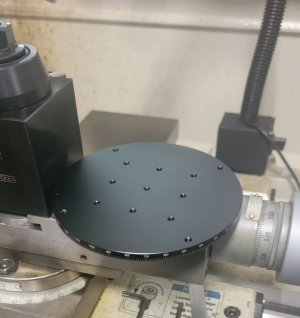Johnwa
Ultra Member
@jcdammeyer i have a 600 ppr optical encoder that I hope to use as a standard. I plan to gear it up by about 1:5 with timing pulleys. That will give me about 3000 ppr which should be good enough.
Is that a 150 line encoder or 600 line? Remember in quadrature the # of lines is multiplied by 4. So a 600 line would give you 2400 edges per rev. That's a resolution of 0.15 degrees.@jcdammeyer i have a 600 ppr optical encoder that I hope to use as a standard. I plan to gear it up by about 1:5 with timing pulleys. That will give me about 3000 ppr which should be good enough.
I can’t find my order but I think it was this one.Is that a 150 line encoder or 600 line? Remember in quadrature the # of lines is multiplied by 4. So a 600 line would give you 2400 edges per rev. That's a resolution of 0.15 degrees.
The board has a circular outline with a few pieces lopped off. The sensor is in the center of that circle. The outline of the board is centred between the 4 screw holes in the stepper. Fairly easy if you have a 3D printer. I assume that alignment is fairly critical.
I can’t find my order but I think it was this one.
Note in the description.I can’t find my order but I think it was this one.
Proximity switch or mechanically triggered travel switch is a good choice, you can make it linkage control your spindle switch (because your feed power comes from the spindle)I've been waiting for one of you smart guys to find the right electronic gizmo. Ideally, at least on my style of lathe, it should be able to integrate the sensor into the middle area now occupied by cast iron. The T-slot area is off limits & outside of that is running out of room or intersects other important features. The tool post underside could be modified with some kind of sub plate or recessed if it was a simple magnet.
How does one interpret those Ali documents in terms of measurement accuracy? 1-deg? 0,1 deg? Depends on radius? Even if the lathe compound was a more difficult future project, I see value in the gadget for angular indexing without the breaking out the rotary table. Like a chuck rotating on a dedicated plate mounted to mill table. Or upright spin indexer (although the pin system does offer some degree of positioning as is).
Here’s an alternative AS5600 board. It’s a little easier to mount.
I'd be *very* surprised to see anything electrical anywhere near the corners. I've ordered 4 just to mess around with.The corner to corner dimension on that is 32.5mm. My stub is only 26mm in diameter. So that wouldn't fit without cutting off the corners. I'm not against doing that though as long as that does not affect the boards functionality by cutting any circuit paths.
I'd be *very* surprised to see anything electrical anywhere near the corners.

Clickspring does this all the time to deal with thin brass parts
Yup. I'd try it as I think it would be less sketchy than trying to grip the edge.I glued some aluminum wheel spacers to my faceplate...... Skeptical, I was.... work, it did. I took fairly light cuts especially in the beginning.
I suggest trying a piece of scrap aluminum and seeing what it takes to un-glue it. Heat is the enemy of the bond though, so keep that in mind. (look at me telling an engineer to build and destroy.... Lol I do believe that's the life mission of the breed, is it not?) 😎
